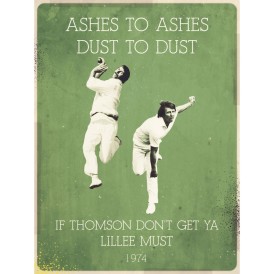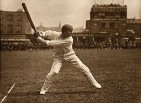You Need Speed (part one)
Archie Mac |
“Those who do not learn from history are doomed to repeat it”.
Those famous words relate to many aspects of human endeavour. In Ashes cricket, and particularly Ashes cricket in Australia, the lesson to learn is that the team with the best fast bowlers, especially if those bowlers are dangerously fast, wins.
Before we compare the current fast bowlers and tell you who will win the Ashes in 2017/18, let’s have a look at how the fast men have regularly dominated Ashes cricket in Australia.
1920/21
Before Warwick Armstrong opened with his two fast bowlers – Jack Gregory and Ted McDonald – in this series, the established practice was to start with one fast and one slow bowler.
The two speedsters didn’t actually combine until the third Test but the new blitzkrieg, from the high-leaping Gregory and the smooth as silk McDonald, helped to destroy the war-ravaged Englishmen. The Aussies, led by the ‘Big Ship’, won five-nil. Thanks to Armstrong’s innovation opening batsmen would now forever be selected for their ability to combat two, new ball sharing, fast men.
1932/33
In the 1970s the West Indies captain, Clive Lloyd, ceased selecting his average spinners and instead let loose four quality fast bowlers. This led to an outcry at the demise of Test cricket with no more front foot shots like the off and on drive. Four fast bowlers inevitably led to the proliferation of bouncers, the use of helmets and all sorts of new protective padding.
They say what’s old is new again and Lloyd’s all-pace attack was actually first utilised by Douglas Jardine with the tactic known as Bodyline. The uncompromising Jardine, he was known as the Iron Duke, had even more advantages than Lloyd. He could place as many fieldsmen as he liked behind square leg so he stacked the legside and had his pace attack, led by the lighting fast Harold Larwood, bowl at the batsmen’s bodies and heads.
England, despite opposition from the great Don Bradman, won 4-1 but it spelled the end of Jardine and Larwood’s Test careers as both were exiled for failing to apologise to the Aussies. Bodyline also left Bradman salivating for revenge.
1946/47
Bradman waited 14 years and through a World War before he had his revenge. His ruthless use of speedsters Ray Lindwall and Keith Miller made for an acrimonious series. Miller in particular did not agree with his captain’s merciless tactics but, like a good military man, he followed orders and helped crush the enemy 3-0 with a liberal sprinkling of bouncers – or bumpers as they were then called.
Bradman’s theory was simple; when you had the fast bowling ammunition you showed no mercy and put the opposition to the sword. A young professional English batsman on his first Ashes tour – Len Hutton – learned the Bradman theory well, perhaps too well.
1954/55
Hutton brought with him two fast bowlers. Brian Statham, quick and accurate, and a balding scholarly fast bowler with a marathon run up in Frank Tyson. The side was particularly strong when it’s remembered England left another fine fast bowler at home in Fred Trueman, although this was probably for reasons other than cricket.
Tyson proved a flop in the first Test, claiming 1-160 as Australia won by an innings. Two things happened in the second Test: the first, Tyson halved his run up; the second, the still quick Lindwall felled Tyson with a bouncer which left him unconscious and with a huge lump on the back of his head.
From then on Tyson blew the Aussies away with England winning 3-1, and earned the sobriquet Typhoon Tyson. Some said he was the fastest bowler ever seen in Australia. Others demurred and thought Larwood had him, but only just.
1958/59
England arrived in Australia as indisputably the best team in the world and were expected to repeat their Ashes victory of 1954/55. In the end they left humbled 4-0 and were out bowled and out captained by the new Aussie skipper – Richie Benaud.
Writing ’out bowled’ may have caused some of the English press covering the series to scoff. There were all sorts of allegations that the Australian pace bowlers either threw or dragged to the point of cheating. The dragging was fixed by the change from a back-foot to front-foot no ball law (much to the lifelong chagrin of Benaud); the throwing controversy continues still.
The last comment on this tour should go to Jack Fingleton who bravely opened for Australia in the Bodyline tour against Larwood. Fingleton titled his book on the series Four Chukkas to Australia.
1970/71
England had one real quick bowler of class and that was the poetry-writing John Snow. Unlike his namesake of House Stark, he was not born a bastard, but he could be one with the ball. On his day, and he had to be in the mood, Snow could be almost unplayable and was quite prepared to bowl bouncers at helmetless tail enders.
Thanks to Snow and the batting of Geoff Boycott, England won the only seven match Test series likely to be played 2-0. Due to the general slow scoring throughout the summer, Australia entered the last Test down 0-1 and still had a chance to draw the series. If the Aussies had managed to win( they only lost by 62 runs) it would have been an injustice as England was clearly the better team. The sixth Test did see the debut of a raw fast bowler with an ungainly action – Dennis Lillee.
1974/75
England, after their success of 1970/71, decided to stack their team with fast bowlers. Unfortunately they ran into an Australian side with faster bowlers and, as Ashes history shows, faster beats fast almost every time. Lillee was back after a career threatening back injury. His action was now the ideal model for any fast bowler and he was eager to make up for lost time.
The Englishmen may have been wary of Lillee but they did not expect his partner, Jeff Thomson, to be too much of a problem. After all, his only previous Test against Pakistan had yielded him 0-110, for which he blamed a broken foot. In the end the English were battered and bruised as Thomson, from a slinging action, had the ability to make the ball rise chest high from a length and his sandshoe crusher became legendary.
Australia won 4-1 and no one who watched Thommo would concede that Tyson or Larwood could possibly have bowled faster.




Leave a comment